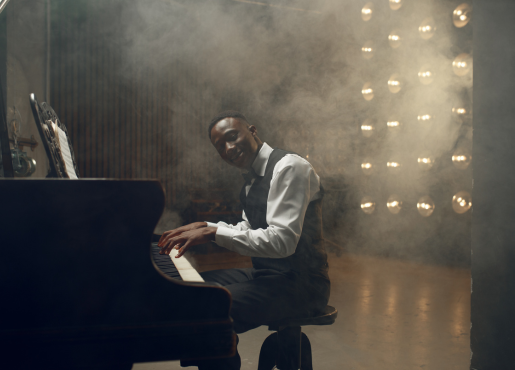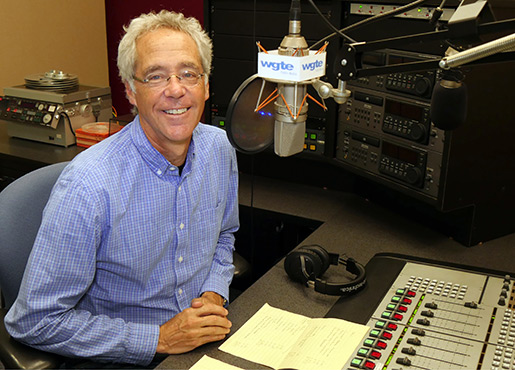
The Duke Ellington and Count Basie Orchestras in the 1950s and 1960s
By Kim Kleinman, Jazz Spectrum Contributing Writer
Someone asserted, quite wrongly Fritz and I think, that Keith Jarrett’s 1970s American quartet was the last great jazz band. Wait a minute! Just off the top of my head I quickly nominated Woody Shaw’s 1980s band and the Dave Holland Quintet of the early 2000s and asked Fritz what he thought. We’ve had great fun with this not-simply-rhetorical question, just the latest in our decades-long conversation about this music.

What makes a great band? Leaders, compositions, players, a certain longevity and body of work all must be part of it. Sure, but which parts in which proportions? The great thing is that we all have slightly to radically different ideas on these questions.
Fritz invited me to bring these questions front and center by creating an hour – two sets – that allow me, and we hope you, to explore the matter, while listening to some damn good jazz.
While I think it helps to compare and contrast, this is NOT a battle of the bands. Music is not in my view competitive, even if rivalries and preferences exist, as well as the trope of the cutting session. But as listeners we only benefit because we have a very fine version of Art Blakey’s Jazz Messengers and Miles Davis’s first great quintet at the same time. And Miles’s second great quintet forming during the heyday of Charles Mingus’s band with Eric Dolphy. And Ahmad Jamal and Oscar Peterson with their contemporaneous longstanding trios in the 1950s. And Ornette Coleman’s and John Coltrane’s early 1960s quartets rearranging our ears.
Let’s start, though, with big band royalty—the Duke and the Count, never Edward and rarely Bill—among the last survivors of the Swing Era. Ellington was never just a big band leader though, and , let me argue, that the 1950s and beyond allowed him and Billy Strayhorn a new opportunity to create enduring music, thematic and swinging, with their suites. Among my favorites are Such Sweet Thunder, inspired by Shakespeare and, later, The Far East Suite. “Star Crossed Lovers” and “Isfahan” are exquisite songs in their own rights, and they are enriched by the musical contexts from which they emerge.
The Basie band always had that Kansas City swagger, their blues brassy and insistent. The 1950s saw the band reinvigorated, thanks to charts by Neal Hefti and a section trumpeter named Quincy Jones. That hot band could raise the temperature even higher when singer Joe Williams came out front. We hear “Everyday I Have the Blues” as tonight’s example of that power. But they could also be charming and subtle; “Lil Darlin’” is pretty enough to fit between the Ellington classics.
Both bands recorded with Frank Sinatra, so that offers its own point of comparison. Both melodic and lushly orchestrated, “I Like the Sunrise” is from Ellington’s Liberian Suite and gives the singer a sophisticated melody to embellish. With Basie, Sinatra is the saloon singer he always claimed to be. “I Won’t Dance” drips with smoky resignation.
The Newport Jazz Festivals in 1956 and 1957 were chances for each band to reassert their importance. The Ellington band was there first. It had new compositions for the occasion and “Festival Junction” kicked off the Columbia Records LP from the date, which was released shortly thereafter. The tune stretches things out to wonderful effect. “Jeep’s Blues” is a welcome vehicle for Johnny Hodges, the band’s nonpareil altoist. The following year, the Basie band showed up at Newport, and their set was largely given over to a reunion of veterans and old friends including Lester Young, Jimmy Rushing, Roy Eldridge, and Illinois Jacquet. But before the guests arrived, they warmed up with an at- the- time- untitled tune with lots of soloists, including their distinctive pianist taking more than one chorus. It appears here as “Swinging at Newport.”
We end the hour with Basie’s swinging “April in Paris” complete with the false endings to repeat that glorious fanfare.
“…one more, once.”
- Home
- Schedules
- TV
- TV
- Local TV Programs
- Business | Life 360 with Kristi K.
- Toledo Stories
- To The Point with Doni Miller
- Listening with Keith Burris
- Ideas & Insights
- WGTE Presents
- BL360: Northwest Ohio Innovation Consortium
- Magic of the Old West End
- Freedom Means Never Surrender
- I&I: The Random Factor
- FF: National Cherry Festival
- TTP: Moms Demand Action For Gun Sense in America
- Watch Live
- Radio
- Education
- Community
- Support
- About
- Donate
- Watch Live



